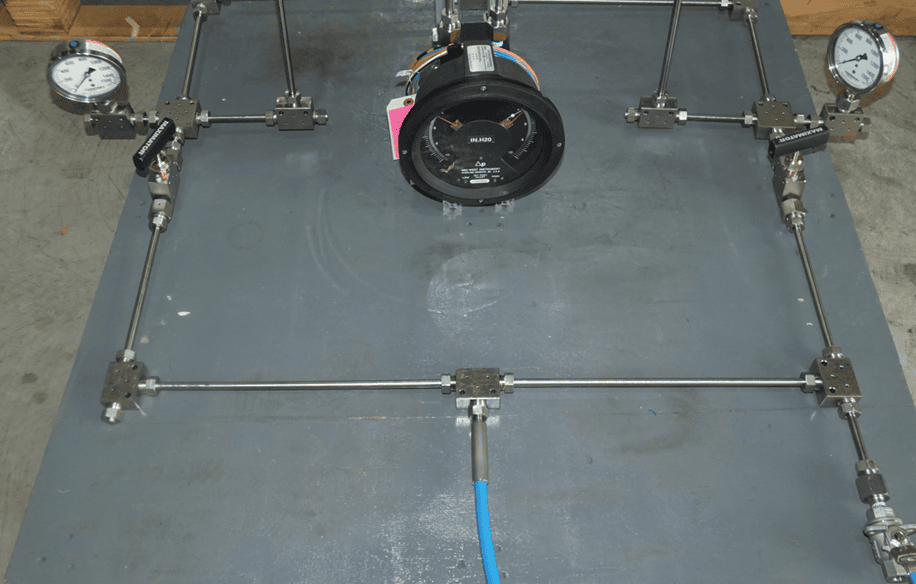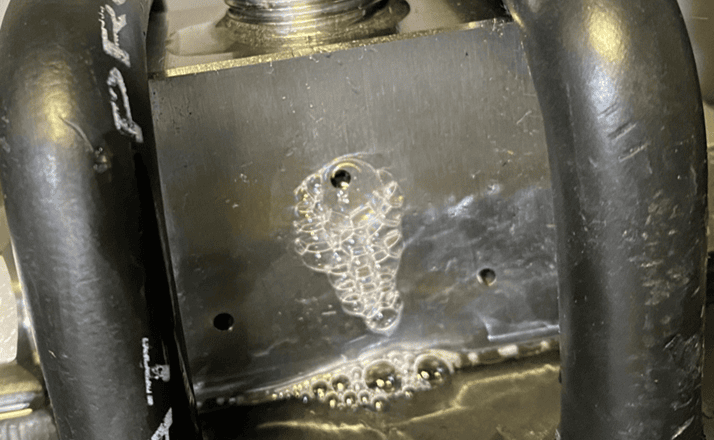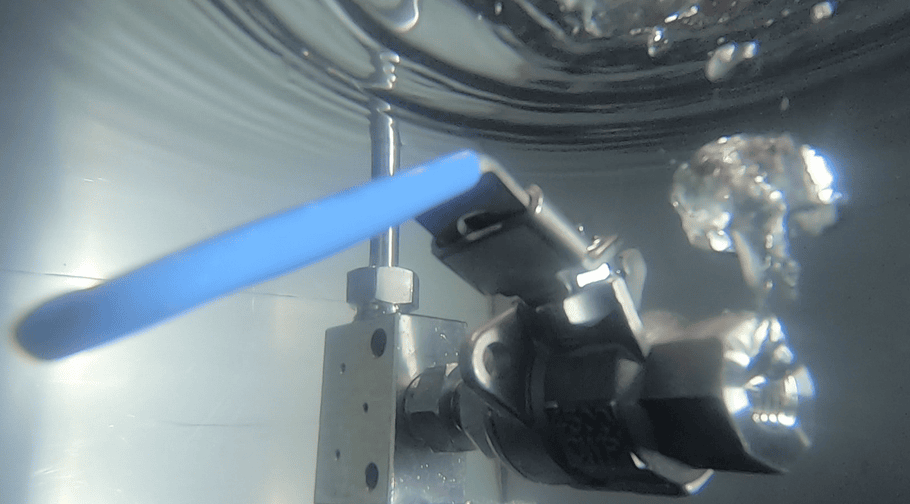Pneumatic leak testing is a process used to verify the safety and reliability of a component or complete assembly. Accurate leak testing is critical in industries such as Chemical, Food, and Pharmaceuticals to prevent downtime and produce products as expected. Automotive, Aerospace, and Medical applications also rely on leak testing to maintain safety and quality across operations.
While traditional methods use an inert gas to pressurize the internal cavities and visually check for leaks, modern testing uses highly accurate vacuum systems to detect fine Helium molecules. This process is known as mass spectrometer testing or Helium leak testing.
At Maximator Test, we can conduct pneumatic leak testing internally at pressures up to 11,250 psig using Nitrogen, Helium, or a Hydrogen/Nitrogen mixture. We can also use our Helium leak detector equipment to detect a leak rate of 5 x 10^-9 mbar l/s in sniffer mode or 5 x 10^-13 Pa m^3/s in vacuum mode.
Our team is eager to assist you with your mandatory pneumatic leak testing needs. Our services include:
- Pressure decay leak testing
- Submersible leak testing
- Differential leak testing
- In-line leak testing (where applicable)
- Forward flow leak testing
- Mass spectrometer or Helium sniffer testing
We aim to deliver cost-effective, precise results for new production products, as well as newly installed or recently repaired systems. We keep a strong focus on safety, quality, and attention to detail in all of our testing services.
Pneumatic Leak Testing Features and Benefits
Pneumatic leak testing is used to determine safe operating pressures, detect hard-to-find leaks, understand maximum capacities, and verify the integrity of joint fittings. This testing method can be used with intricate internal cavities where purging air is difficult for a hydrostatic test. Components suitable for pneumatic testing include pressure valves, welded pipes, fuel lines or hoses, and pressurized tanks.
Pneumatic testing is ideal when there are contamination concerns, especially internal contamination, as it eliminates the use of liquid that can introduce particulates or corrosion. It’s also ideal when a quick increase in pressure is preferred. In some applications, water or oil droplets may be too large to show visual leakage. Helium can be the best option in these cases, as Helium’s small atoms can reveal the finest leaks.
Pneumatic Leak Testing Applications
Pneumatic leak testing is useful in many different industries and applications. These include but are not limited to:
- Automotive. HVAC compressors or transfer pipes, air intake castings, hoses, EVAP canisters and valves
- Aerospace. Fuel transfer pipes and hoses, separation components, coolant manifolds, hermetically sealed components
- Medical. High purity plastics, catheters, drug delivery bags, hypodermic needles and syringe housings
- Pipe Transport. Welded pipe joints, offshore components, pump housings
With the growing Hydrogen Fuel industry, the adaptability of pneumatic leak testing is increasingly important. Test articles such as accumulators, fuel cells, weldments, and adaptors can only be accurately tested with this method after considering the dangers of Hydrogen. Propulsion systems that use Nuclear or Hydrogen fuel are also an important market and can benefit from the increased safety and quality assurance pneumatic leak testing offers.
Pneumatic Leak Testing Vs. Hydrostatic Leak Testing
Several key differences must be considered when comparing pneumatic and hydrostatic leak testing. These include the choice of testing medium, pressure capabilities, detection methods, and contamination concerns. Each testing method offers unique advantages depending on the application’s testing requirements.
Hydrostatic leak testing uses liquids such as water or hydraulic fluid. This method can safely reach significantly higher pressures of up to 145,000 psi at Maximator Test or up to 217,000 psi at our MAXIFES lab located in Nordhausen, Germany. It involves purging the internal cavities of air pockets and visually inspecting for fluid leakage or monitoring pressure drops to identify potential leak paths. Hydrostatic testing is best when the test pressure is likely to cause catastrophic failure. It may not be suitable for high-purity components due to possible contamination from the testing liquid.
In contrast, pneumatic leak testing utilizes inert gases such as nitrogen or helium. This testing process can be conducted at pressures up to 11,250 psi at Maximator Test and up to 15,000 psi at MAXIFES. The process often involves submerging components in water to detect bubbles or using leak detection fluid to pinpoint any leaks.
Pneumatic testing is well-suited for applications where contact with liquids must be avoided or presents additional challenges. There may be high-purity applications where fluids trap particulates or the interval cavities cannot appropriately purge air pockets.
Pneumatic Leak Testing by Maximator Test
At Maximator Test, we emphasize pneumatic leak testing for industries such as Automotive, Aerospace, Medical, and Pipe Transport. This testing is crucial for ensuring the safety and quality of equipment. Pneumatic leak testing is also essential for meeting safety standards associated with SAE, ASME, ISO, UL, and more. We are fully committed to meeting these needs with an unwavering focus on speed, reliability, and efficiency.
Contact the experts at Maximator Test or request a quote for more information. Maximator Test is here to help with your high-pressure testing and related service needs.



